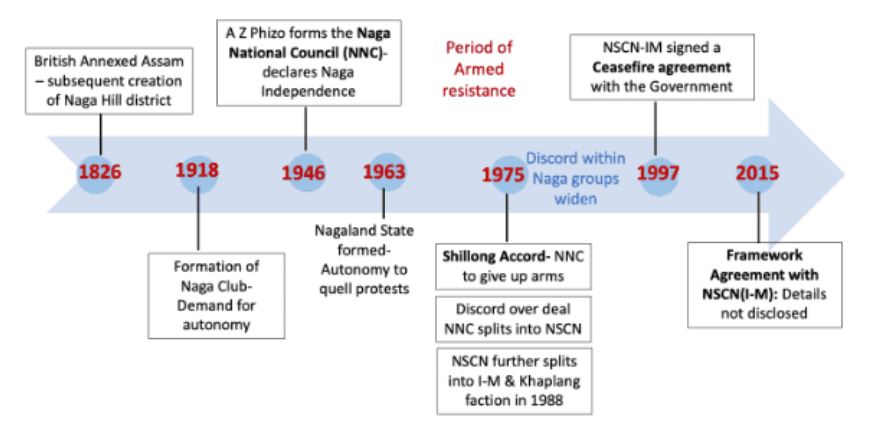UPSC Articles
FEDERALISM/ INDIAN POLITY
Topic: General Studies 3:
- Functions and responsibilities of the Union and the States, issues and challenges pertaining to the federal structure
Talking tough: On the Naga issue
Context: The National Socialist Council of Nagaland- Isak-Muivah (NSCN-IM) has for the first time released the details of the 2015 framework agreement (given in interpretation of agreement part of article)
Do You Know?
- Nagas belong to Indo-Mongoloid Family.
- The Nagas are not a single tribe, but an ethnic community that comprises several tribes who live in the state of Nagaland and its neighbourhood.
Origin of Naga Issue and the timeline of the events
The assertion of Naga Nationalism began during Colonial period and continued in Independent India. Below is the pictorial representation of the timeline

What are the key demands of the Naga groups?
- Greater Nagalim (sovereign statehood) i.e redrawing of boundaries to bring all Naga-inhabited areas in the Northeast under one administrative umbrella.
- It includes various parts of Arunachal Pradesh, Manipur, Assam and Myanmar as well.
- Naga Yezabo (Naga Constitution)
- Naga national flag.
What was the Ceasefire Agreement which was signed in 2015?
- Signatories: Interlocutor R.N. Ravi signed the agreement on behalf of the Centre in presence of PM Modi. The other two signatories were leader of NSCN(IM) i.e. Isak Chishi Swu, who died in 2016 and Thuingaleng Muivah (86) who is leading the talks.
- Takeaway of the Agreement: The Government of India recognised the unique history, culture and position of the Nagas and their sentiments and aspirations. The NSCN(IM) also appreciated the Indian political system and governance.
- Significance: It shows the governments strong intent to resolve the long standing issue and adoption of diplomatic peaceful approach by Naga Society to fulfil their aspirations.
- Objective: Both sides agreed that October 2019 for concluding an accord, which would settle all Naga issues
- Shrouded in Secrecy: The details of the agreement have not been made public by the government citing security reasons
What has happened in the year’s post signing the agreement?
- Enlarged Peace Talks: Talks were expanded in 2017 by including other Naga groups under the banner, the Naga National Political Groups (NNPGs)
- Bilateral to Multilateral Negotiations: The Framework Agreement envisaged a bilateral truce between two entities, but today it is seen to be a multilateral one with involvement of seven prominent Naga groups
- Deadlock in Talks Since October 2019: The deadlock was on the insistence for a separate flag and constitution by the NSCN(IM) to make way for India and Nagaland to be independent allies in a shared-sovereignty federal relationship
- Differences within Naga Groups: The NSCN (I-M) still insists on a “Greater Nagalim”. However, most of the NNPGs based in Nagaland have sought to settle the issue without disturbing the State boundaries while keeping the “Greater Nagalim” question in abeyance
What are the present grievances of NSCN-IM?
- Interpretation of Agreement
- The agreement released by the NSCN-IM in August 2020 stated “sharing the sovereign power” and provide for an “enduring inclusive new relationship of peaceful co-existence of the two entities”.
- The NSCN-IM claims that the word ‘new’ is politically sensitive as it goes to define the meaning of peaceful co-existence of the two entities (two sovereign powers) and it strongly indicates outside the purview of the Constitution
- The position of NSCN(IM) has been “with India, not within India”.
- Conceding to this demand, especially after the abrogation of Article 370, seems improbable for the Government.
- Grievances against Mr. Ravi (Interlocutor & also Nagaland Governor)
- The NSCN-IM has claimed that Mr. Ravi, “craftily deleted the word new from the original” to justify his own narrative and circulated to the other Naga groups including NNGPs
- NSCN-IM is also angered by Mr. Ravi’s letter to Nagaland CM, alleging the collapse of law and order and that armed gangs who question the sovereignty and integrity of the nation” were engaging in “blatant extortion”.
- This has touched a sore spot for the NSCN (I-M) as the group defended the practice by terming it “tax collection”.
- The NSCN (I-M) has demanded that Nagaland Governor R.N. Ravi should be removed as the interlocutor for talks on the Naga accord.
Way Ahead
- Any moves to alter boundaries will intensify ethnic conflicts and insurgencies beyond Nagaland.
- The accord can be concluded after consultations with Assam, Manipur and Arunachal Pradesh, all States which have a stake in the matter.
- The Central government needs reiterate its commitment to finalising the Naga accord while seeking to re-engage with the NSCN (I-M) without giving in to its arbitrary demands.
Connecting the dots;
- Article 371
- Divide & Rule Policy of British













